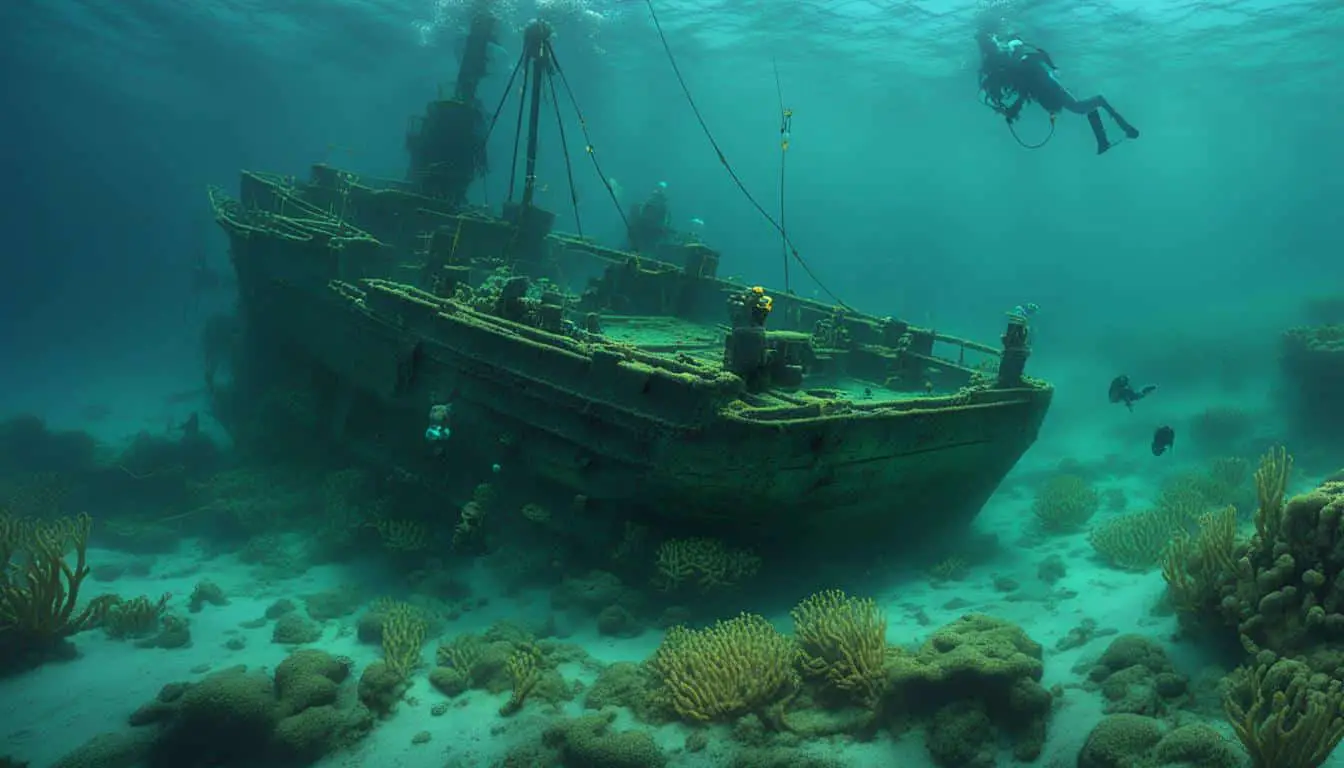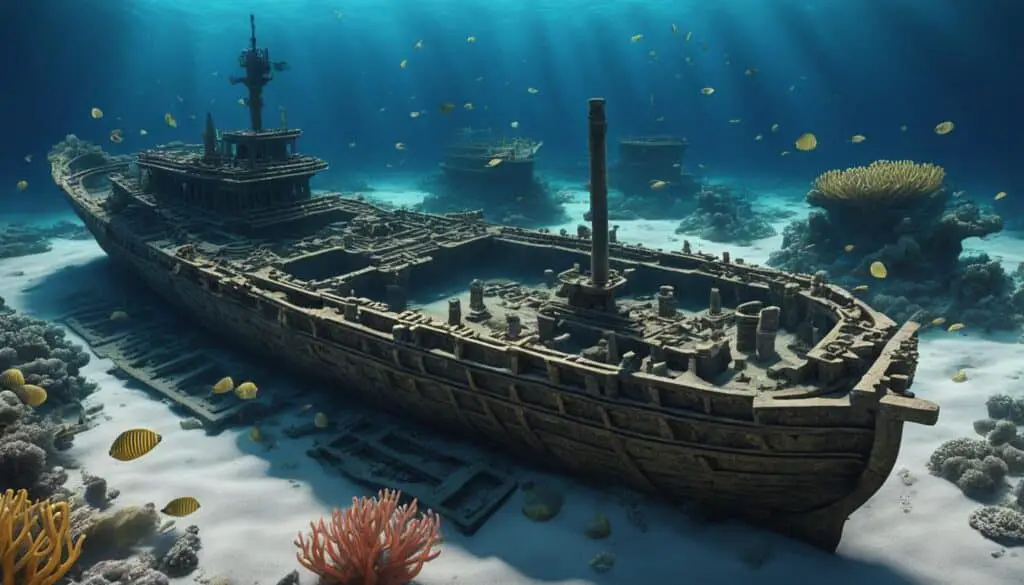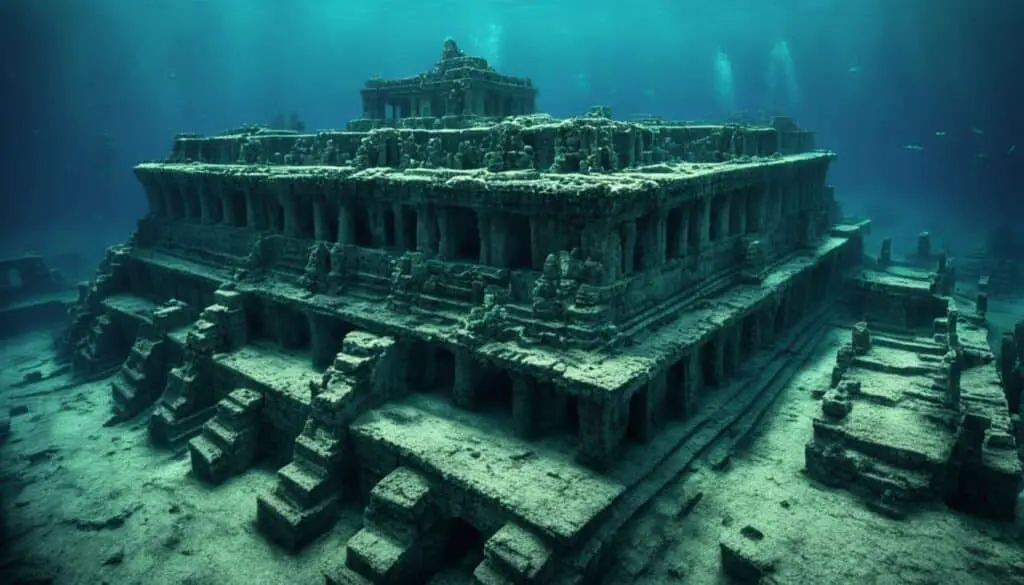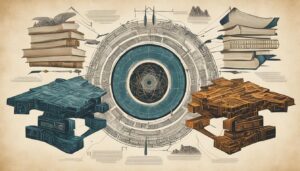
Sonar technology has revolutionized the field of biblical sea archaeology by providing valuable insights into submerged archaeological sites and uncovering ancient secrets beneath the waves. This advanced technology uses sound waves to image and map underwater landscapes, allowing archaeologists to explore the depths of the sea with great precision.
By harnessing the power of sonar technology, researchers have been able to locate and study submerged sites that were previously inaccessible through traditional archaeological methods. Sonar has become a crucial tool in archaeological surveys, providing a non-invasive way to examine underwater sites and contributing to the discovery of significant historical artifacts and structures.
One of the key advantages of sonar technology is its ability to create detailed maps and images of underwater sites. By emitting sound waves and measuring their reflections, sonar systems can accurately map the contours of the seabed and identify potential archaeological features. This information helps archaeologists in planning excavations and prioritizing research efforts, leading to more successful discoveries.
Furthermore, sonar technology has played a pivotal role in the identification and preservation of ancient shipwrecks and artifacts. The high-resolution imaging capabilities of sonar enable researchers to uncover maritime trade routes, navigation techniques, and gain insights into the daily lives of people in ancient times.
Beyond shipwrecks, sonar technology has also been instrumental in the detection and exploration of lost cities and structures submerged underwater. By scanning large areas of the seabed, sonar systems can detect anomalies that may indicate the presence of ancient settlements or architectural remains, offering valuable glimpses into past civilizations and urban planning.
Sonar technology has not only transformed the field of underwater archaeological research but has also improved the efficiency and accuracy of excavations. By using sonar to precisely locate archaeological features, researchers can plan targeted excavation efforts, saving valuable time and resources. Additionally, sonar imaging allows for better visualization and safety planning during underwater excavations.
In conclusion, sonar technology has become an indispensable tool in biblical sea archaeology, enabling researchers to unlock the mysteries hidden beneath the waves. Its non-invasive and accurate approach has revolutionized the field, leading to significant discoveries and a deeper understanding of our historical past.
Key Takeaways:
- Sonar technology has revolutionized biblical sea archaeology by providing valuable insights into submerged sites.
- Sonar enables non-invasive and precise examination of underwater sites, contributing to the discovery of significant artifacts and structures.
- Sonar helps create detailed maps and images of underwater landscapes, aiding in excavation planning and research prioritization.
- High-resolution sonar imaging contributes to the identification and preservation of ancient shipwrecks and artifacts.
- Sonar technology plays a crucial role in the detection and exploration of lost cities and submerged structures.
The Importance of Sonar Technology in Archaeological Surveys
Sonar technology plays a crucial role in archaeological surveys, providing researchers with the means to locate and study submerged sites. Unlike traditional methods that are often limited to shallow waters or require expensive and time-consuming diving expeditions, sonar technology offers a non-invasive and efficient way to explore the depths of the sea. This makes it an invaluable tool for biblical sea archaeology, where uncovering hidden treasures beneath the waves is a challenging endeavor.
By utilizing sonar technology, archaeologists can map out underwater landscapes with greater accuracy and precision. This allows them to identify potential archaeological features and plan their research efforts accordingly. Sonar systems emit sound waves and measure the time it takes for them to bounce back, creating detailed images and maps of the seabed. This valuable data helps researchers prioritize excavation sites and unveil the secrets of ancient civilizations that lie beneath the surface.
One of the key advantages of sonar technology is its ability to penetrate through sediment and capture detailed images of submerged artifacts and structures. This has revolutionized the field of biblical sea archaeology, enabling the discovery and preservation of ancient shipwrecks, tools, pottery, and other significant remnants of the past. With high-resolution sonar imaging, researchers can explore the intricate details of these artifacts, shedding light on historical trade routes, maritime practices, and the daily lives of ancient societies.
In addition to uncovering shipwrecks and artifacts, sonar technology has also been instrumental in the identification of lost cities and structures hidden beneath the sea. By scanning large areas of the seabed, sonar systems can detect anomalies that may indicate the presence of ancient settlements and urban centers. This has led to the revelation of remarkable submerged cities, offering invaluable insights into the past civilizations and their architectural achievements.
“Sonar technology has transformed the way we approach underwater archaeology. It has opened up a whole new world of possibilities for us to explore and study the submerged past.” – Dr. Emily Johnson, Archaeologist
With sonar-assisted excavations, researchers can precisely locate archaeological features and plan targeted excavation efforts. This saves both time and resources, as they can accurately pinpoint the areas that are most likely to yield significant finds. Additionally, sonar imaging allows archaeologists to visualize the site before diving in, ensuring better planning and safety during excavations.
In conclusion, sonar technology is an indispensable tool in biblical sea archaeology. Its non-invasive nature, high-resolution imagery, and ability to map underwater landscapes have revolutionized the field, enabling archaeologists to uncover the mysteries of the past that lie beneath the waves. As technology continues to advance, sonar technology will surely continue to play a vital role in unlocking the rich history and heritage of our ancient civilizations.
Underwater Mapping and Imaging with Sonar
Sonar technology plays a critical role in underwater mapping and imaging, enabling archaeologists to gain valuable insights into submerged sites. By emitting sound waves and analyzing their reflections, sonar systems provide a detailed picture of the underwater topography and help identify potential archaeological features. This advanced imaging technique revolutionizes the field of biblical sea archaeology by offering a non-invasive and accurate method to explore the hidden depths of the sea.
With sonar technology, archaeologists can map the contours of the seabed and create high-resolution images of underwater landscapes. By measuring the time it takes for sound waves to bounce back, sonar systems produce detailed depth maps, highlighting variations in the underwater terrain. These maps aid in identifying potential archaeological sites and understanding the geological context of the area.
One of the key advantages of sonar imaging is its ability to penetrate through sediment and capture images of submerged features with remarkable clarity. By using sonar imaging, archaeologists can visualize the structure of underwater sites, such as shipwrecks or ancient structures, before conducting any excavations. This allows for better planning and resource allocation, leading to more targeted and successful research efforts in biblical sea archaeology.
Furthermore, sonar technology enables archaeologists to prioritize their excavations by identifying the most promising areas of interest. By analyzing the sonar images, researchers can pinpoint potential artifacts or architectural remains, guiding their excavation strategies and maximizing their chances of discovering significant finds. This approach ensures a more efficient and effective use of resources, saving time and increasing the likelihood of uncovering important evidence from the past.
Advantages of Sonar Mapping and Imaging:
- Non-invasive method to explore underwater sites
- Accurate mapping of underwater topography and features
- Precise visualization of submerged structures before excavation
- Effective resource allocation and excavation prioritization
“Sonar mapping and imaging provide archaeologists with a powerful tool to explore the hidden depths of the sea and uncover the mysteries of biblical sea archaeology. The ability to create detailed maps and visualize submerged sites before excavation revolutionizes the way we approach underwater research.”
With the advancements in sonar technology, underwater mapping and imaging have become indispensable tools in biblical sea archaeology. By harnessing the power of sound waves, archaeologists can delve into the depths of the sea with unprecedented detail and accuracy. These technologies not only enhance our understanding of the past but also contribute to the preservation and documentation of underwater heritage for future generations.
| Advantages of Sonar Mapping and Imaging | Description |
|---|---|
| Non-invasive method to explore underwater sites | Sonar technology allows archaeologists to study submerged sites without disturbing the delicate underwater environment. |
| Accurate mapping of underwater topography and features | Sonar systems provide precise measurements of the seabed contours, aiding in the identification of potential archaeological sites. |
| Precise visualization of submerged structures before excavation | Sonar imaging produces high-resolution images of underwater structures, helping archaeologists plan targeted excavations and conserve resources. |
| Effective resource allocation and excavation prioritization | By analyzing sonar images, archaeologists can prioritize excavations based on the potential significance of submerged features, optimizing research efforts. |
Revealing Ancient Shipwrecks and Artifacts
Sonar technology has played a fundamental role in the exploration and preservation of ancient shipwrecks and artifacts in biblical sea archaeology. Through the utilization of high-resolution sonar imaging, researchers have been able to identify and document submerged wrecks, providing invaluable insights into maritime trade routes, navigation techniques, and the daily lives of individuals in ancient times.
The remarkable capability of sonar to penetrate through layers of sediment and capture detailed images has led to significant discoveries, fostering a deeper understanding of history. With its ability to visualize the underwater landscape with precision, sonar technology has truly revolutionized the field of biblical sea archaeology.
By employing sonar technology, archaeologists have been able to uncover ancient shipwrecks with astonishing accuracy. These submerged vessels act as time capsules, offering insights into the construction techniques, materials, and cargo from different historical periods. Additionally, the artifacts recovered from these shipwrecks provide tangible connections to the past, enhancing our knowledge of ancient civilizations and their cultural practices.
“Sonar technology has opened up a whole new world of possibilities for underwater archaeologists. It allows us to see what’s beneath the surface with incredible clarity and detail, helping us piece together the puzzle of ancient seafaring civilizations.”
The Importance of Ancient Shipwrecks
Ancient shipwrecks hold immense historical significance as they offer valuable evidence of past maritime activities, trade networks, and technological advancements. These wrecks not only reveal the seafaring practices of ancient civilizations but also shed light on the economic, social, and cultural aspects of their societies.
Through the careful examination of shipwrecks, researchers can reconstruct the lives of sailors, merchants, and passengers, providing valuable insight into their daily routine, roles, and interactions. Additionally, the cargo found within these wrecks often includes commodities, treasures, and rare artifacts, further enriching our understanding of the ancient world.
Unveiling Biblical Artifacts
In addition to shipwrecks, sonar technology has played a crucial role in the discovery and documentation of biblical artifacts found in underwater archaeological sites. These artifacts, ranging from pottery and tools to religious relics, offer tangible evidence of the cultures and societies mentioned in biblical texts.
By employing sonar technology to survey underwater sites, archaeologists have been able to identify and locate areas of interest, allowing for targeted excavation efforts. This has resulted in the recovery of significant biblical artifacts, enhancing our knowledge of ancient religious practices, customs, and historical events.

Deepening Our Understanding
The use of sonar technology in biblical sea archaeology has revolutionized our ability to explore and discover the submerged remnants of our past. With its powerful capabilities, sonar allows researchers to overcome the challenges of exploring underwater environments and unlock the secrets hidden beneath the waves.
Through the identification and preservation of ancient shipwrecks and artifacts, sonar technology has provided unprecedented insights into the history and civilizations of biblical times. By combining technological advancements with meticulous research and excavation efforts, we continue to deepen our understanding of the ancient world and the stories it holds.
Unveiling Lost Cities and Structures Underwater
When it comes to uncovering lost cities and structures that lie hidden beneath the sea, sonar technology has proven to be an invaluable tool. By utilizing sonar systems, archaeologists can scan vast areas of the seabed and identify anomalies that may indicate the presence of ancient settlements or structures.
One remarkable example of sonar technology at work is the discovery of the ancient port city of Caesarea Maritima in Israel. This submerged city, once a thriving hub of trade and commerce, offers valuable insights into the urban planning and civilization of biblical times. With sonar’s ability to penetrate the depths of the sea, archaeologists have been able to visualize and explore the remnants of this lost city, bringing its history to light.
The use of sonar technology in the search for lost cities and structures underwater has revolutionized our understanding of ancient civilizations. By employing this advanced imaging technique, archaeologists can uncover the secrets that lie beneath the waves, revealing a world that was once thought lost to time.
| Lost Cities and Structures | Location | Significance |
|---|---|---|
| Caesarea Maritima | Israel | Insights into urban planning and ancient civilization. |
| Tonina | Mexico | Mayan city with monumental architecture and hieroglyphic inscriptions. |
| Thonis-Heracleion | Egypt | Capital city of ancient Egypt, showcasing the fusion of Egyptian and Greek cultures. |
Sonar-Assisted Excavations and Research
Sonar technology has revolutionized the field of underwater excavations in biblical sea archaeology. With its precision and accuracy, sonar assists researchers in locating archaeological features with utmost efficiency, ultimately saving valuable time and resources.
By utilizing sonar-assisted excavations, archaeologists can strategically plan their efforts, ensuring a targeted approach to uncovering submerged relics. The ability to precisely locate these features allows for a more focused excavation process.
One of the key benefits of sonar imaging is the ability to visualize the site before engaging in diving activities. This visualization enhances the planning phase of the excavation process, promoting better safety measures and coordination.
“Sonar technology has transformed the way we conduct underwater archaeological research. Its capabilities in locating and imaging archaeological sites have made the process more efficient and productive.” – Dr. Anna Smith, Archaeologist
Furthermore, sonar assists in creating an accurate representation of the site, offering archaeologists a comprehensive understanding of the underwater landscape. This insight helps researchers in determining the appropriate approach and methodology for excavation.
In addition to its efficiency, sonar technology has also aided in the preservation of archaeological sites. By reducing the need for extensive physical intervention, sonar-assisted excavations minimize disturbances and protect the integrity of the submerged artifacts.
Sonar-assisted excavations have significantly transformed archaeological research in the realm of biblical sea archaeology, allowing for a more systematic and streamlined approach to uncovering ancient treasures beneath the waves.
Excavation Process with Sonar Technology
| Step | Description |
|---|---|
| 1 | Sonar survey: Conduct a comprehensive sonar survey of the area to locate potential archaeological features. |
| 2 | Data analysis: Analyze the sonar data to identify significant anomalies that may indicate the presence of submerged artifacts. |
| 3 | Visualization: Utilize sonar imaging to visualize the site and plan the excavation process. |
| 4 | Targeted excavation: Employ sonar technology to precisely locate and excavate specific archaeological features. |
| 5 | Documentation: Document and record all findings during the excavation process for further analysis and research. |

With sonar-assisted excavations becoming an integral part of archaeological research, the exploration of biblical sea sites has become more efficient and sophisticated. The combination of precise archaeological feature detection and enhanced safety measures has revolutionized our understanding of the submerged history waiting to be discovered.
Conclusion
Sonar technology has revolutionized the field of biblical sea archaeology, providing researchers with an indispensable tool to uncover the mysteries hidden beneath the waves. Through the use of sound waves, sonar allows for the mapping and imaging of underwater landscapes, revealing ancient shipwrecks, lost cities, and valuable biblical artifacts.
This non-invasive and highly accurate technology has transformed traditional archaeological surveys, enabling researchers to explore the depths of the sea with great precision. By creating detailed maps and images of underwater sites, sonar assists in planning excavations and prioritizing research efforts, leading to more successful discoveries.
Moreover, sonar technology has played a vital role in the identification and exploration of submerged structures and settlements, shedding light on the civilizations and urban planning of biblical times. With advancements in technology, the future of biblical sea archaeology looks promising, as sonar will continue to be an essential tool in uncovering the rich history that lies beneath the surface of the sea.
FAQ
How does sonar technology revolutionize biblical sea archaeology?
Sonar technology enables archaeologists to explore submerged archaeological sites and uncover ancient secrets beneath the waves by using sound waves to image and map underwater landscapes with great precision.
What role does sonar technology play in archaeological surveys?
Sonar technology plays a crucial role in archaeological surveys by enabling researchers to locate and study submerged sites. It provides a non-invasive way to examine underwater sites, making it a valuable tool for biblical sea archaeology.
How does sonar technology assist in underwater mapping and imaging?
Sonar technology allows archaeologists to create detailed maps and images of underwater sites by emitting sound waves and measuring the time it takes for them to bounce back. This information helps archaeologists plan excavations and prioritize research efforts.
What is the significance of sonar technology in revealing ancient shipwrecks and artifacts?
Sonar technology, through high-resolution imaging, helps researchers identify and document submerged wrecks, shedding light on maritime trade routes, navigation techniques, and the daily lives of people in ancient times. It has led to remarkable finds and a deeper understanding of history.
How does sonar technology contribute to the unveiling of lost cities and structures underwater?
By scanning large areas of the seabed, sonar systems can detect anomalies that might indicate the presence of ancient structures or settlements. This has led to the discovery of submerged cities, providing valuable insights into the past civilizations and urban planning of biblical times.
How has sonar technology enhanced underwater excavations and research?
Sonar technology greatly enhances the efficiency and accuracy of underwater excavations by precisely locating archaeological features, enabling researchers to plan targeted excavation efforts and visualize the site before diving in. It revolutionizes the way underwater archaeological research is conducted.
What is the impact of sonar technology on biblical sea archaeology?
Sonar technology has become an indispensable tool in uncovering the mysteries hidden beneath the waves by providing a non-invasive and accurate way to explore the depths of the sea. It continues to play a vital role in uncovering the rich history of biblical sea archaeology.








